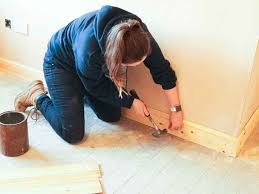Skirting boards are usually overlooked when preparation the inner design of an area, however they supply a finishing touch and essential usefulness. Skirting boards not merely cover the space involving the floor and wall surface, but they also provide safety for the wall from home furniture marks, dirt, and dirt. Picking the right skirting board can add value to your home and boost the general beauty. In this particular information, we will provide you with an entire idea of skirting boards, their varieties, materials, installation, and upkeep.
Kinds of Skirting Boards
There are several choices to select from when selecting skirting boards, and you will find one which fits your style and spending budget requirements. The most common kinds of skirting boards consist of:
a) Moulded – These are the basic most widely used form of skirting boards, with an array of profiles, like Ogee, Torus, and Chamfered. They can be easily available, inexpensive, as well as simple to setup.
b) Bullnose – This kind of skirting boards features a rounded advantage, which is perfect for contemporary and minimal design.
c) Torus – Torus skirting boards have a semi-rounded profile which offers a timeless appearance and matches both contemporary and conventional style.
d) Sq . Edge – This sort of skirting board has a clean and straightforward style that fits modern-day design and style.
Materials for Skirting Boards
Skirting boards are made of many different materials, and every substance features its own advantages and drawbacks. The most typical components for skirting boards consist of:
a) MDF – This product is affordable, easy to set up, and can be decorated or discolored to fit the room’s inside.
b) Wooden – Wooden skirting boards provide an classy look and are suitable for standard design and style. One can choose from a selection of woods, such as Oak, Ash, and Pine. Nonetheless, they are often pricey and require regular routine maintenance.
c) PVC – PVC skirting boards are resilient, inexpensive, and simple to set up. They can be resistant against humidity and suitable for bath rooms and kitchen areas.
d) Steel – Aluminum skirting boards give a minimalist seem and are suitable for modern design and style. These are resilient, flame-resistant, and demand reduced maintenance.
Setting up Skirting Boards
Installing skirting boards calls for some DIY abilities, and it’s essential to adhere to the manufacturer’s recommendations. This is a step-by-stage method for installing skirting boards:
a) Calculate the size of the wall and cut the skirting board appropriately.
b) Ensure that the skirting board fits correctly and label the positioning for repairing.
c) Drill holes within the skirting board and wall and put in the wall structure plugs.
d) Resolve the skirting board towards the walls employing screws or sticky.
e) Complete the gaps and nail or attach pockets using hardwood filler.
Maintenance of Skirting Boards
Skirting boards need minimum upkeep, but it’s crucial to keep them clean and free of dust and dirt. Dependant upon the materials, use a moist material or perhaps a remember to brush to completely clean the skirting board. Wooden skirting boards may require typical oiling or waxing to preserve their stand out and dampness resistance.
Bottom line:
window boards offer both usefulness and looks to the interior decorating of the room. Selecting the best skirting board needs considering aspects including type, materials, set up, and routine maintenance. This article supplies a comprehensive comprehension of skirting boards, their types, supplies, set up, and servicing. Hopefully this informative guide aids you in choosing the right skirting board for your house, so that it is more desirable and important.



